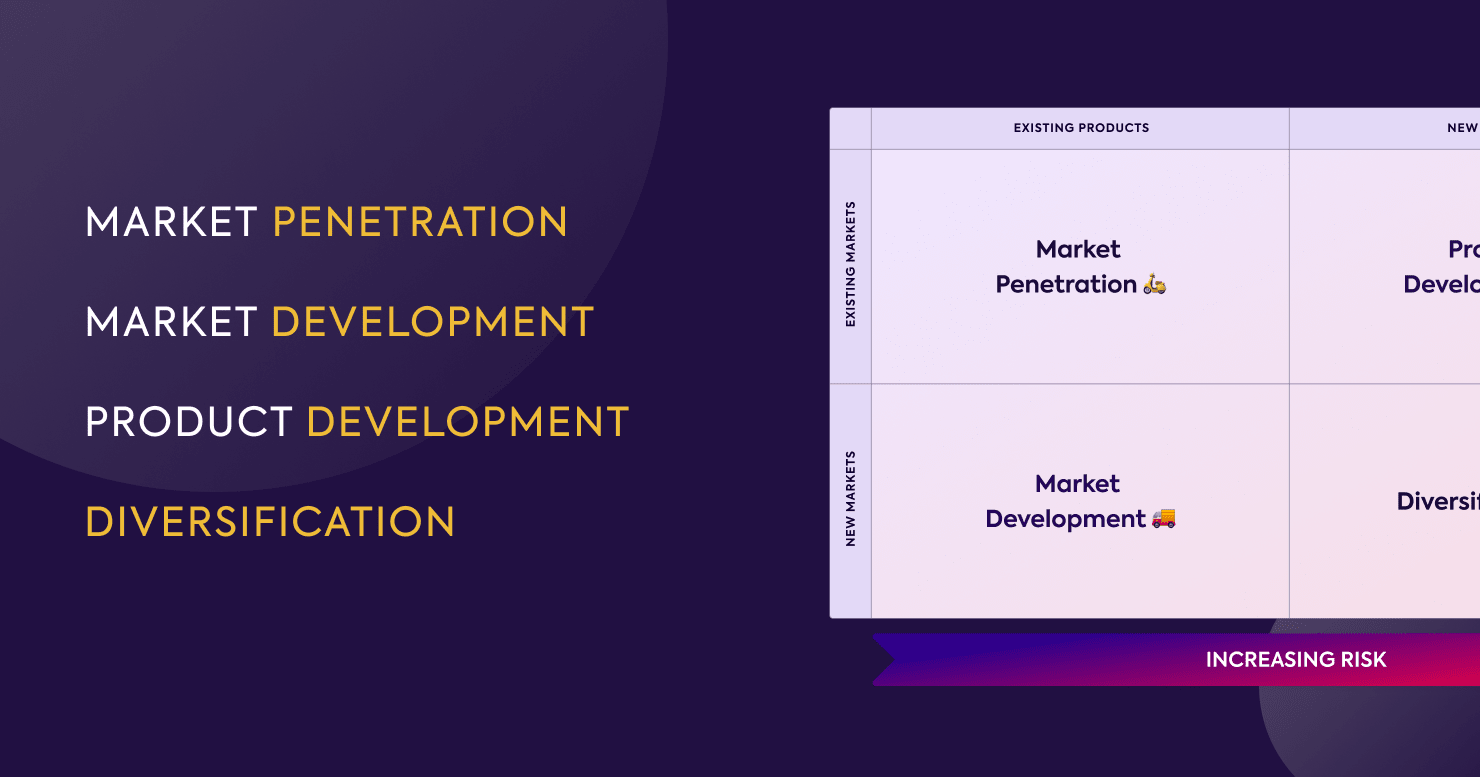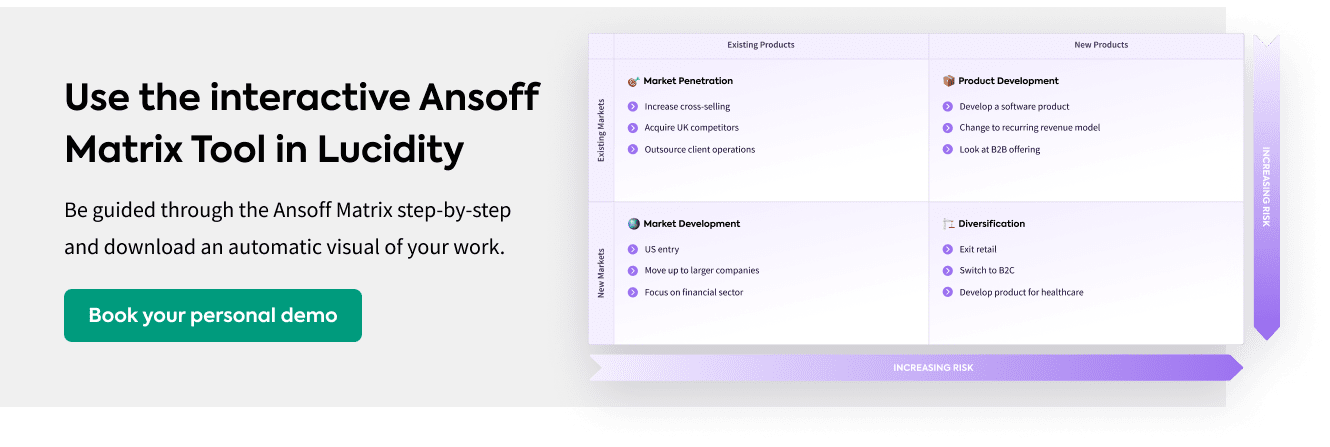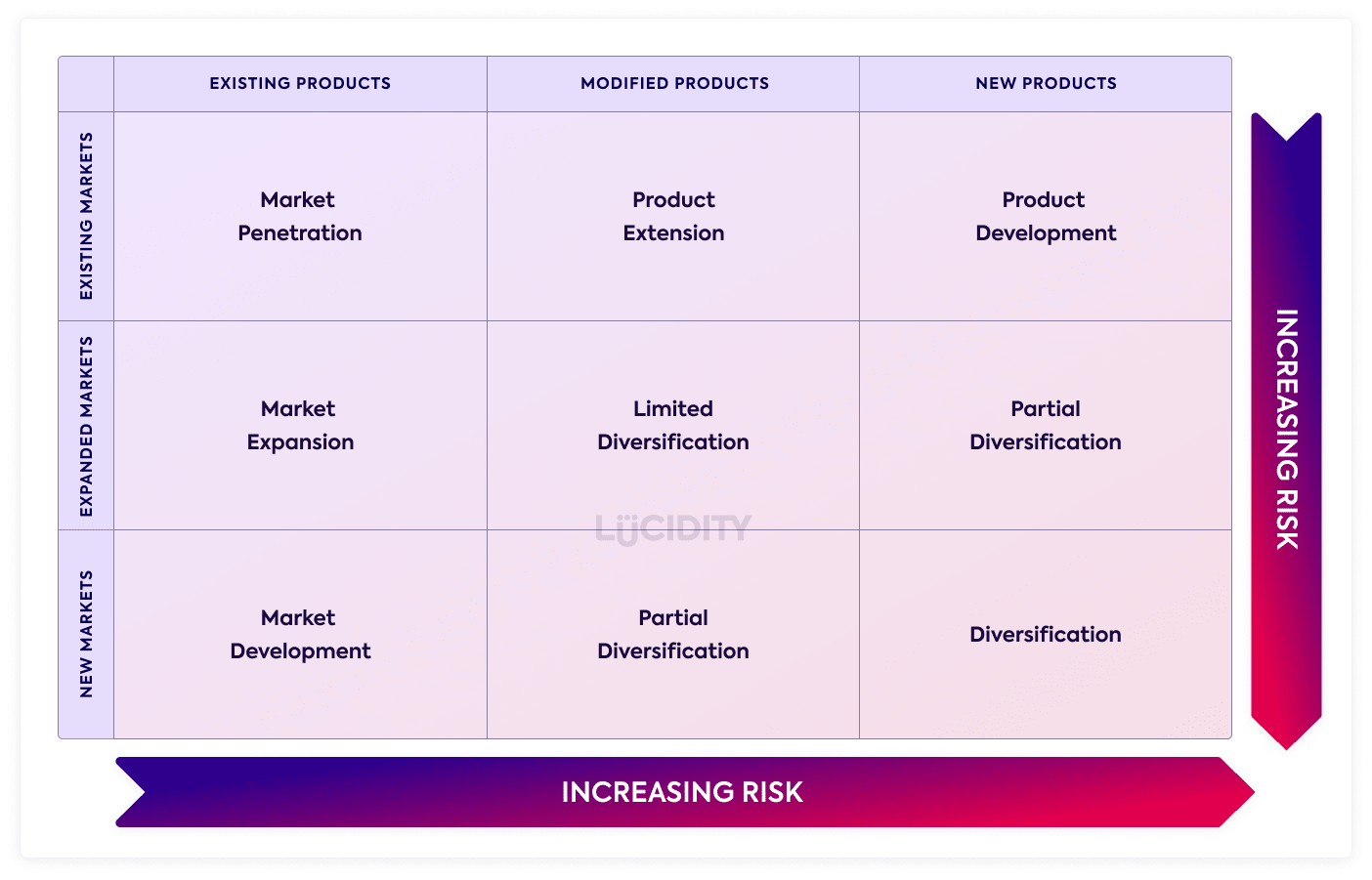The Ansoff Matrix is a famous tool used to generate and classify different strategies and approaches to a market.
It’s a 2×2 matrix that mapping out New / Existing Customers against New / Existing Markets, which provides you four quadrants of strategy classification. They are Market Penetration, Product Development, Market Development and Diversification.
The risk of each approach is very different, so Ansoff helps you look at strategic options with risk analysis.
This guide will provide everything you need on the Ansoff Matrix. Frequently asked questions, explainers and guides to help you understand the Ansoff Matrix so well you can use it in work or perhaps even your home life, though that would be a little strange…
Ultimately this tool is all about planning your continued business growth. So, let’s begin!
Beginner Guide to The Ansoff Matrix
Link: An Introduction to Ansoff Matrix
Perhaps you’ve never heard of The Ansoff Matrix before? If that’s the case there’s no better place to start than this article. It covers all the basics about the popular model including:
- Definition of the Ansoff Matrix
- Explanation around Market Penetration
- Explanation around Product Development
- Explanation around Market Development
- Explanation around Diversification
- Advantages and disadvantages
- Preparation and tips
It’s the best resource to understand the detail behind the Ansoff Model before looking elsewhere in this guide. Once you’re done, or if you’ve heard of Ansoff before, it’s time to take a look at some of the other recommendations below.
How to use the Ansoff Matrix
The three steps to work through the Ansoff Matrix are simple but time consuming when done well. It’s important you work through the right analysis, as the decisions you’re making are significant in their business impact.
Step 1: Look at the analysis of the business
Prior to completing an Ansoff Matrix you should have at least a completed SWOT Analysis, and ideally some sort of external analysis such as PESTLE or Five Forces. This is important as you’re going to need to have a good understanding in order to develop strategic options and evaluate which strategy will work for you.
Step 2: Work through the quadrants
In this step you’ll work through each of the quadrants and list out potential activities or strategies that the business could take. Refer to the opportunities and strengths in your SWOT and try to come up with at least one strategic option per quadrant.
Link: Market Penetration as a Strategy
Start with Market Penetration, as on paper this is the least risky of the strategy classification. In this quadrant you are selling your existing products or services to existing customers. This strategy can often require effective selling to power growth, so that’s exactly what the above article talks about. Examine a little more of the thinking behind a Market Penetration strategy and download a series of campaigns and tips to focus on your existing marketplace.
As you move outside of Market Penetration and towards diversification consider the different approaches, including the geographic, industries and markets you can enter. Here are some helpful links:
Link: Diversification as a Strategy
Diversification is the riskiest part of the Ansoff Matrix. It’s a well-known and successful route to protecting and growing businesses, but also one that many have failed at. This resource is a complete guide to Diversification that contains:
- Introduction to diversification
- How to evaluate your opportunity
- Key tips and advice
- Examples of good diversification
- Examples of bad diversification
If you’re going to diversify this is a must read!
Link: Diversification Webinar
If reading guides isn’t your thing (if so, well done for getting this far!) we have a great webinar on the topic of diversification that you can watch. It covers the following:
- Frameworks used around diversification such as SWOT and Five Forces
- How to evaluate your diversification options
- A breakdown of the Ansoff Matrix
- Real case studies of successful diversification
Once you’ve completed your strategic options it’s time to move on to evaluation…
Step 3: Evaluate options
Link: Evaluate strategic options using the SFA Matrix
Your Ansoff Matrix may encounter lots of potential options from continued focus on your current market through to a complete pivot. Deciding which strategic option requires some careful consideration and thankfully there’s a framework to help you do just that. This guide to the SFA Matrix will help you look at the following:
- The suitability of the strategic option
- The feasibility for the company
- The acceptability for the stakeholders
Run any strategic options through this model and you’ll come out with the one that best suits your plans to move forward.
Ansoff Matrix In A Workshop Environment
Link: Running a workshop with Ansoff
The Ansoff Matrix is commonly used in offsite strategy workshops to determine ideas and approaches to growth. In this article we take a look at one method called Ansoff Roulette. It discusses:
- The trade-off between risk and profitability within options
- A how-to for the Ansoff Roulette game
- A process of deciding your strategic options
Ansoff works best in a workshop when some prep work is done in advance, so make sure you check out SWOT, PESTLE and Five Forces as example models to complete beforehand.
Ansoff Toolkits
Office 365 Suite
PowerPoint, Excel and Word are often used in composing quasi-Ansoff style diagrams in order to map out options. It’s not overly effective at producing inspiring graphics, but Excel does a decent job at producing a SFA Matrix. As with any document based strategy plan, you always have the risk of it being buried in a virtual drawer, referenced only once a year.
Whiteboard
Generating ideas at a top level can often be done via sticky notes and a whiteboard, which can be an effective way of running things like Ansoff Roulette. This approach can be lively and engaging during a workshop environment but often lacks robust follow-ups, losing some of the energy when photos of the board are emailed or notes captured.
Ansoff Matrix Software
You guessed it! 🙌 Lucidity has the ability to create your strategic options, goals and KPIs, in order to decide how to progress. It’s the easiest and most effective way to complete an Ansoff Matrix… 👍
Learn more in Video form
Not keen on reading large documents? Watch our short, sharp introduction to Ansoff Matrix by heading over to our Ansoff Matrix Video Guide.
The Extended 9-box Ansoff Matrix
There is a version of Ansoff that contains 9 boxes rather than 4 boxes, giving more finesse and sophistication to the strategic options available.
The increasingly popular version of Ansoff contains two new quadrants:
- Partial diversification
- Limited diversification
- Market expansion
- Product expansion
As the diagram shows above, these two types of diversification occur when business modifies products or expand existing markets. These smaller steps towards diversification are often less risky and less costly in order to see a return.
Cadburys chocolate in the UK is a good example of this small step approach to diversification, with numerous new flavours released regularly from the Diary Milk line, but ultimately still targeting chocolate lovers.
Summary
Whether it’s the 4 box or the 9 box version, the Ansoff Matrix is a commonly used framework that has proven to be valuable in helping companies diversify and grow for decades.
We’ll end on some advice from René Moolenaar, a Senior Lecturer who includes Ansoff in his teaching…
"Ansoff’s ‘product’/market matrix can de deceptively easy to apply at first sight, however, each quadrant or growth option needs to be considered carefully given the potential significant number of ‘ideas’ in each one of them, and all with their own risk profile and suitability, acceptability and feasibility profile."
Good luck with your strategic options!














